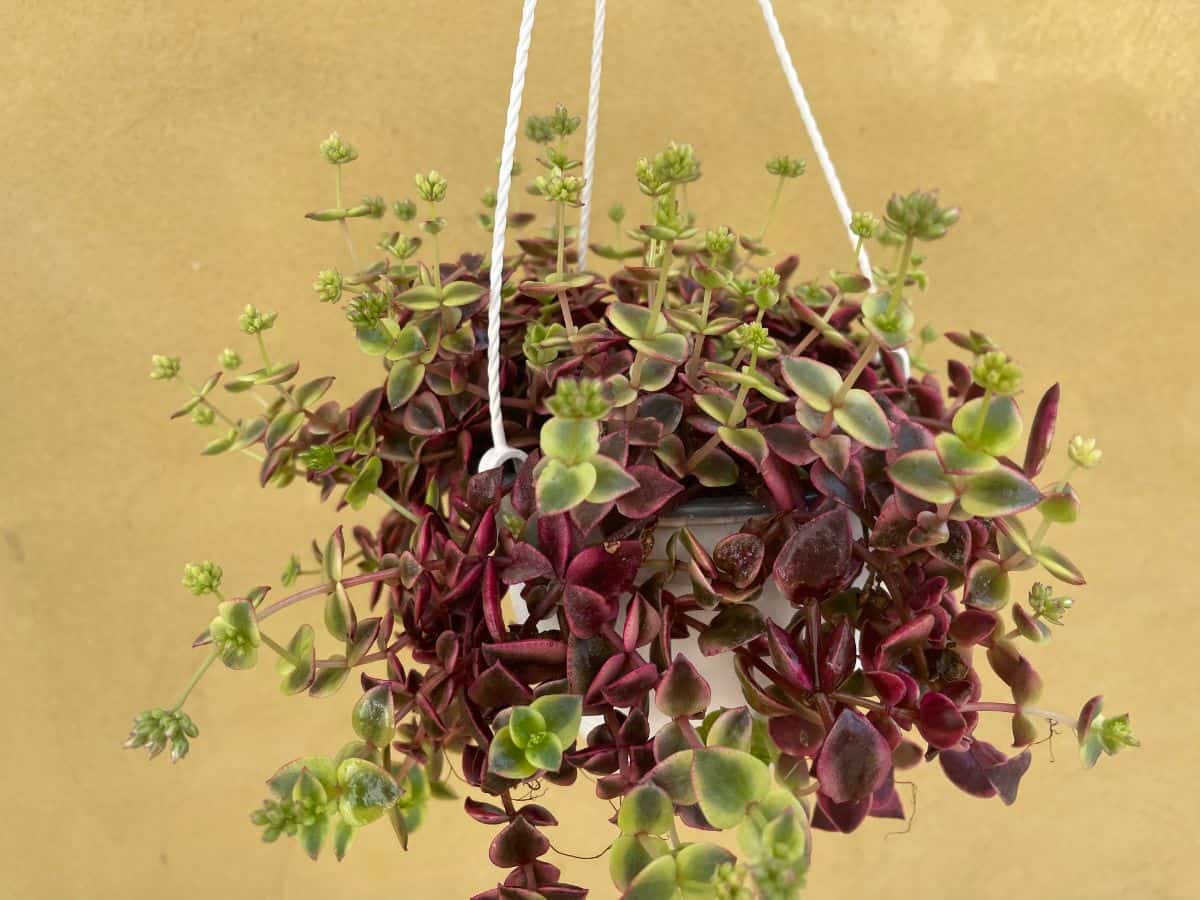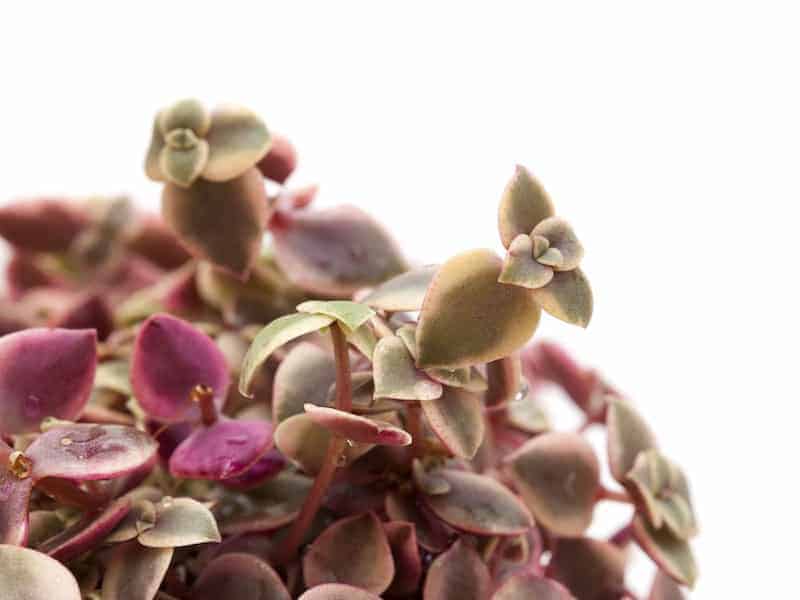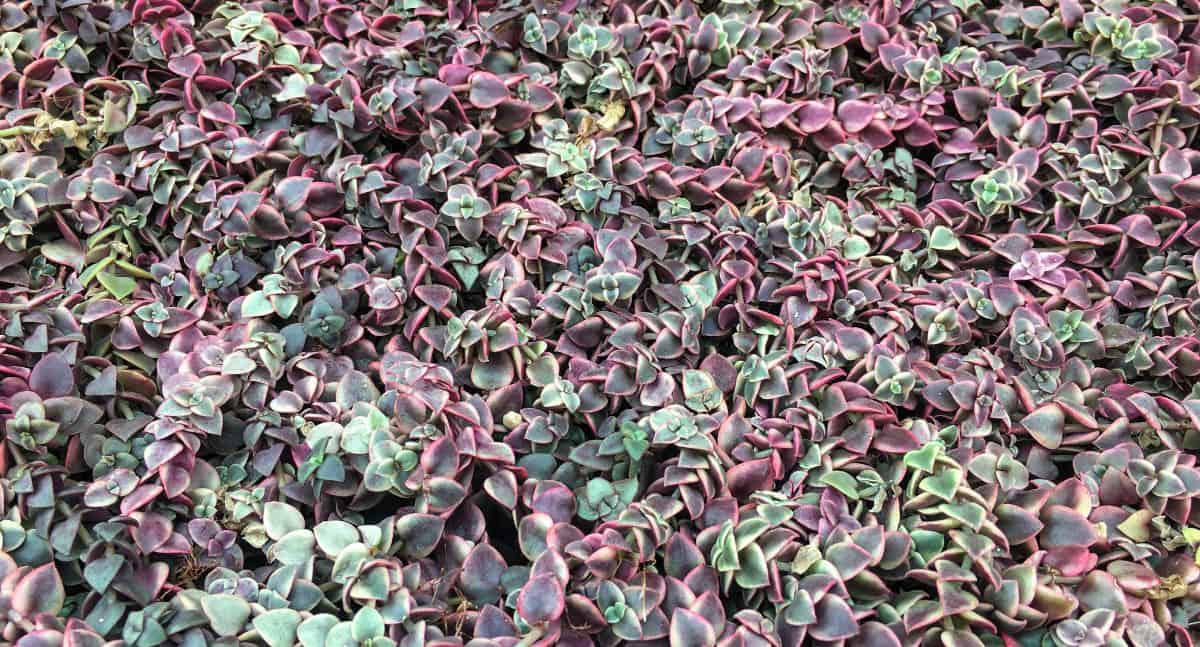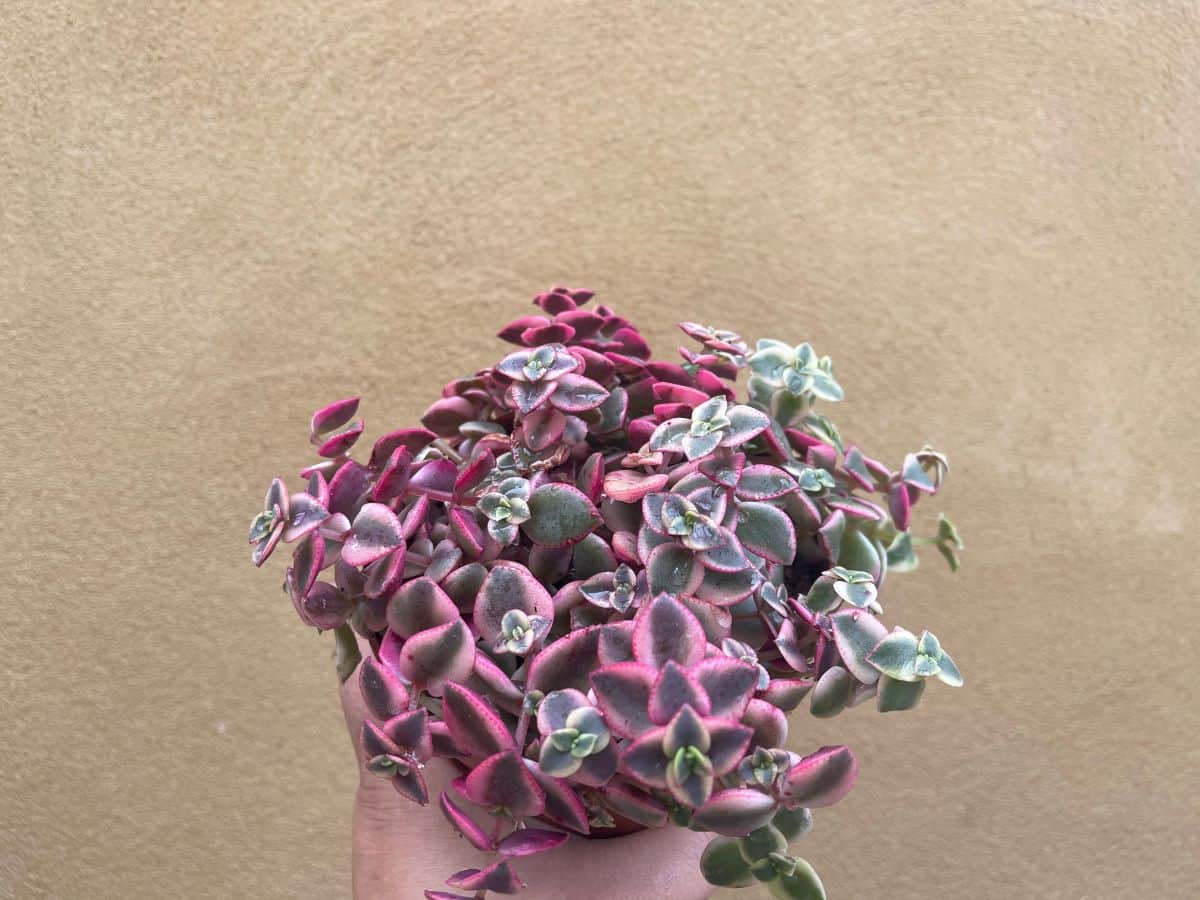The Crassula marginalis rubra is an exceptionally pretty succulent. It is also sometimes called the Calico Kitten. Its beautiful heart-shaped leaves make it quite unique.

The Crassula marginalis rubra is native to South Africa. They are not very hardy plants, and require quite a lot of care and nurturing. They are not fast growers, but, with the right care, will eventually get going and grow well.
They love hanging down from their pots, rather than growing upright. They are ideal plants for hanging baskets, as they will come cascading down in a spectacular display of green, pink, and purple.
Jump to:
Crassula Marginalis Rubra Appearance
| Name: | Crassula marginalis rubra |
| Soil: | Cactus potting mix with perlite or coarse |
| Blooming: | Spring |
| Light: | Full to partial sun |
| Water: | When the soil is completely dry |
| Propagation: | Stem cutting and leaves |
The Crassula marginalis rubra, or Calico kitten, grows wild, trailing along the ground and spreading out. In pots, they tend to hang over the sides, and make beautiful container plants.
The leaves are an interesting mix of colors, ranging from deep purple to numerous shades of pink, to green. They have an unusual heart shape, and the leaves are variegated.

Buy it from:
The plant will flower towards the end of spring, into the start of summer. The flowers are small white blossoms that will appear on the tips of the branches.
The Crassula marginalis rubra is not a very tall plant. It will reach a maximum height of only about 6 inches.
Caring for the Crassula Marginalis Rubra
These plants are fairly delicate and are not tough and hardy. But with the right care and regular attention, they will flourish and give a magnificent display.
Light
The Crassula marginalis rubra needs full to partial sun in order to do well. If you are planting it in your garden, choose a spot that gets approximately 6 hours of direct sunlight every day.
If you have started your plant indoors, and then want to transfer it to the outdoors, you will need to introduce it to outdoor conditions very gradually. Take it out for short periods initially, gradually increasing the number of hours every day, until the plant is fully acclimatized to outdoor natural sunlight.

If you want to grow these plants indoors, their favorite spot will be close to a window that gets direct sunlight for most of the day. They will not thrive if they do not get enough direct sunlight, but will shrivel and die.
At the same time, if they are exposed to very intense direct sunlight for too long, the heat may kill them. Keeping them happy with just the right amount of sunlight is a delicate balance. It is a good idea to watch them carefully, and if they look like they are starting to wilt, move them to a more shady spot for a while.
No products found.
If you do not have a room that gets enough sunlight every day, it is possible to supplement natural sunlight with a grow light. A grow light can help to provide the light and warmth that your plant needs in order to thrive.
Water
When first planting Crassula marginalis rubra, the new plants will do best if the soil is kept mildly moist initially. However, once your plants are established, and you have healthy succulents growing, the Crassula marginalis rubra needs very little water.
Watering should be done in moderation, and only at infrequent intervals. If you over-water, your plants will be at risk of being infested with fungal infections.
Use pots with ample drainage holes at the bottom, and allow the water to drain completely. Do not let the plant sit in water for a long time, as this will cause it to rot. The best method of watering is to place the pot in a flat dish of water, and allow the plant to absorb the water through the holes in the bottom of the pot. But do not leave it to sit in deep water for too long.
Only water again once the plant and the soil are completely dry. Take care not to over-water.
Temperature

The Crassula marginalis rubra does not like very cold conditions. It will not survive heavy frost or extremely low temperatures.
This succulent likes heat, and if it gets too cold outdoors, especially overnight, it is better to bring your plants inside.
If you have cultivated Crassula marginalis rubra as an indoor plant, try to keep them in a very warm room. They will do best if the temperature is kept constant, as they do not adapt well to drastic changes in temperature.
Soil
It is essential to have the right type of soil, as well as the right soil conditions, in order for your Crassula marginalis rubra to grow and flourish. Any of the following three blends will provide the right soil conditions for your plant.
The best soil is a combination of cactus potting mix, mixed with perlite. The ratio should be 2:1. The cactus potting mix will give the plant the nutrients it needs, while the perlite will ensure good drainage.
Another good soil combination is to combine cactus potting mix with coarse sand, also in a 2:1 ratio. This will give you a sandy soil that will also nourish your plants while allowing sufficient drainage.
The third option is to use a mix of all three of the above, ie: cactus potting mix, perlite, and coarse sand, in a ratio of 1:1:1.
All of these components are readily available from your local nursery or gardening center.
Propagating Crassula Marginalis Rubra

There are a few ways to propagate these plants. The two that are usually the most successful are either to propagate from stem cuttings, or to propagate from leaves.
Cuttings
To propagate a Crassula marginalis rubra from a cutting, it is necessary to cut the stem from a robust plant that looks healthy. Choose a plant that has plump, moist-looking leaves, rather than very dry leaves.
Once you have cut the stem, allow it to dry out for a couple of days. Once it is completely dry, you can accelerate the process, and ensure good growth, if you use some rooting hormone. Simply dip the cut stem in the rooting hormone. If you do not have any, you can leave out this step and it won't make a massive difference.
Put the stem cuttings in a pot of potting mix, and place it in a warm spot, but out of direct sunlight.
Water every 4-5 days, or if the soil feels dry to the touch. After about two weeks you should see new root growth.
After 4-6 weeks, the roots should be growing well, and the plant should be developing. As the plant grows, you can start to increase the exposure to regular sunlight, and cut down on the frequency of watering.
Leaves
It is also possible to propagate Crassula marginalis rubra using a leaf. This is very easy to do, but it is advisable to use at least 3 or 4 leaves, because they may not all survive the process.
Remove a few healthy-looking leaves by twisting carefully, as close to the stem as possible.
Allow the leaves to dry out for 2-3 days.
Place some succulent potting mix in a small dish. Put the leaves into the potting mix, water a little, and cover the dish until the leaves begin to sprout.
Once you see little shoots on the leaves, they can be transferred to a pot with some more potting mix, and cultivated using the method described above for cuttings.
Common Problems

There are a few things that can be problematic when growing Crassula marginalis rubra. However, if you are vigilant and take the necessary precautions, you can prevent these problems from occurring. If they do occur, you can avoid too much damage if you deal with them promptly.
See Related Topic: Crassula Capitella Campfire Succulent Care Guide
Pests
The Crassula marginalis rubra can be prone to pests. The most common pests to affect these plants are mealy bugs and aphids.
The insects can be found on the underside of the leaves, so you need to be on the lookout for them and be careful not to miss them. If allowed to multiply, they will suck on the leaves, draining all the sap.
The best way to treat these bugs is by spraying the plants with an alcohol solution. If you dilute the alcohol slightly with water, it will prevent the plant from getting burnt by the alcohol.
Sun Damage
While these plants need sunlight in order to thrive, if you notice that the leaves are drying out and shriveling, that means that they have been over-exposed to direct sunlight.
Remove the burnt leaves, and move the plant to a shadier spot for a few weeks.
Read Related Article: Crassula Calico Kitten Succulent Care Guide
Over-watering
If you see that the leaves are turning brown and looking limp and soggy, you are probably giving your plant too much water. The Crassula marginalis rubra does not need a lot of water. Too much water will cause the roots and the leaves to rot and develop fungus.
The best treatment for this is to reduce the amount of water and place the plant in a hot, sunny spot for a few days, and it should recover.
Sources:
https://worldofsucculents.com/crassula-pellucida-marginalis-rubra/
https://garden.org/plants/view/147504/Calico-Kitten-Crassula-pellucida-subsp-marginalis-Variegata/


